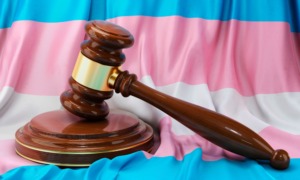
SpeedKingz/Shutterstock
.
“It doesn’t matter if you’re from Kansas or California. In the United States of America, everyone deserves a place to call home.” —Cyndi Lauper
Here’s a question for you: Does a young person from Kansas deserve to be homeless more than a young person from California? It’s a trick question, of course. No one deserves to be homeless at all. Yet California offers some of the nation’s best systems, environment and policies available to youth experiencing homelessness, while those of Kansas lag far behind.

Justin Rush
How is this fair? How is this American? The new State Index on Youth Homelessness provides a snapshot of what each state is doing to address the issue. For youth experiencing homelessness, the state you live in can make all the difference in the world. To get to a sense of where this tangled web came from, let’s rewind a bit — back to the 1770s.
Back in the day, each of the 13 original colonies viewed itself as an independent entity with its own government. When the colonies voted to unite to form a new nation in 1776, they agreed to give some — but not all — of their powers to the federal government. Today — 250 years and 37 states later — states play a critical role in shaping our experiences as Americans. On one hand, state pride can be a warm and wonderful thing. No matter where you might settle down, you’ll always share a certain connection with folks from your neck of the woods. On the other hand, a nation of 50 states makes for a messy patchwork of laws, protections and regulations that can be straight up mind-boggling to keep track of.
An estimated 4.2 million youth and young adults up to age 24 experience homelessness each year in the United States, and we as a nation are not doing enough to change it. That’s why the True Colors Fund in partnership with the National Law Center on Homelessness & Poverty created the State Index on Youth Homelessness, which rates all 50 states and Washington, D.C., on efforts to end youth homelessness. In a nutshell, the State Index is:
- A state-by-state evaluation of the work being done to prevent and end youth homelessness in America.
- A snapshot of the legal, systemic and environmental barriers that youth experiencing homelessness face.
- A guide to help elected officials and government workers improve their state’s work to end youth homelessness.
National problem, state laws

Michael Santos
According to a recent study by Chapin Hall at the University of Chicago, one in 30 youth ages 13 to 17 and one in 10 young adults ages 18 to 25 endure some form of homelessness in the U.S. each year. The study also found that lesbian, gay, bisexual, transgender, queer and questioning (LGBTQ) youth are 120 percent more likely to experience homelessness than non-LGBTQ youth. The State Index takes LGBTQ inclusion into account in its findings and provides recommendations on how states can address the unique needs of LGBTQ youth. And that’s just the beginning. The State Index will be updated annually in order to serve as a barometer of the progress each state makes year over year in their efforts to prevent and end youth homelessness.
Across the board, the systems and laws set up around youth homelessness tend to be difficult to navigate — especially for LGBTQ youth and young people of color. For example, in some states, running away from home is considered a status offense — punishable by law. In other states, curfew laws criminalize youth who have nowhere else to go but the streets. Barriers like these make it much harder for young people to safely access services and move into independence.
But youth are resilient. With appropriate and adequate supports and services, youth experiencing homelessness can rise above their circumstances, escape the cycle of homelessness and have the opportunity to succeed and lead fulfilling lives. Right now, an inspiring class of True Colors Fellows are collaborating on projects to address youth homelessness across the country. Take Advocacy Fellow Lele Exum — a young advocate from Minnesota who’s working to turn the State Index’s recommendations for her home state into a reality.
This fall, America will go to the polls in the most critical midterm election in recent history. You don’t have to wait until then to start making a difference. See how your state scored and tell your governor: “We can do better!”
We’ll generate a personalized email and tweet for you to send to your governor with your state’s score and recommendations for improvement. Now is the time for us to turn our focuses locally, look into the mirror and determine who we want to be as Kansans, Californians, Alaskans and Alabamians. Plus, everyone wants to have warm feelings about where they’re from. This is the perfect way to do that.
Justin T. Rush leads the True Colors Fund‘s work to enact administration and legislative policy change at the federal, state, and local level to prevent and end LGBTQ youth homelessness, with over a decade of grassroots organizing, policy and government affairs experience.
Michael Santos is an attorney at the National Law Center on Homelessness and Poverty whose work focuses on advocating for homeless youth’s access to education through public education, impact litigation and policy advocacy. He received his law degree from the University of Southern California Gould School of Law.































